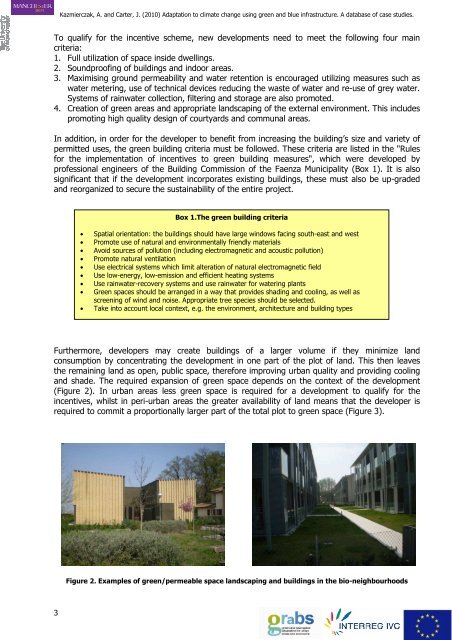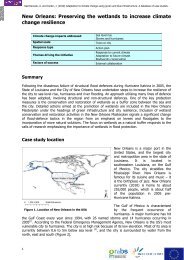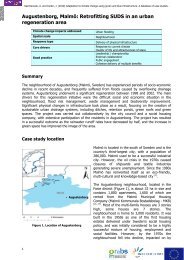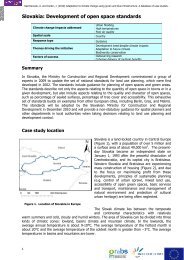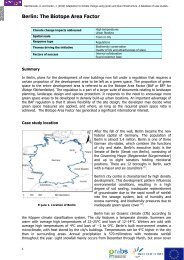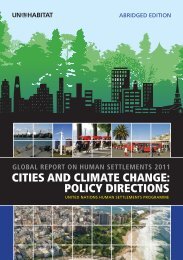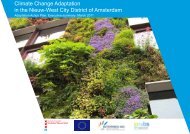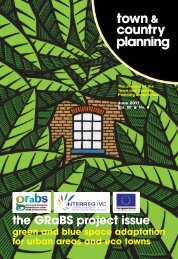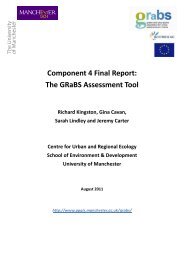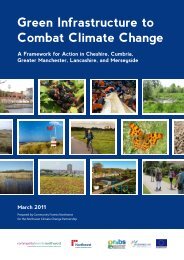Faenza: Extra cubature for developers in return for green ... - GRaBS
Faenza: Extra cubature for developers in return for green ... - GRaBS
Faenza: Extra cubature for developers in return for green ... - GRaBS
Create successful ePaper yourself
Turn your PDF publications into a flip-book with our unique Google optimized e-Paper software.
Kazmierczak, A. and Carter, J. (2010) Adaptation to climate change us<strong>in</strong>g <strong>green</strong> and blue <strong>in</strong>frastructure. A database of case studies.<br />
To qualify <strong>for</strong> the <strong>in</strong>centive scheme, new developments need to meet the follow<strong>in</strong>g four ma<strong>in</strong><br />
criteria:<br />
1. Full utilization of space <strong>in</strong>side dwell<strong>in</strong>gs.<br />
2. Soundproof<strong>in</strong>g of build<strong>in</strong>gs and <strong>in</strong>door areas.<br />
3. Maximis<strong>in</strong>g ground permeability and water retention is encouraged utiliz<strong>in</strong>g measures such as<br />
water meter<strong>in</strong>g, use of technical devices reduc<strong>in</strong>g the waste of water and re-use of grey water.<br />
Systems of ra<strong>in</strong>water collection, filter<strong>in</strong>g and storage are also promoted.<br />
4. Creation of <strong>green</strong> areas and appropriate landscap<strong>in</strong>g of the external environment. This <strong>in</strong>cludes<br />
promot<strong>in</strong>g high quality design of courtyards and communal areas.<br />
In addition, <strong>in</strong> order <strong>for</strong> the developer to benefit from <strong>in</strong>creas<strong>in</strong>g the build<strong>in</strong>g’s size and variety of<br />
permitted uses, the <strong>green</strong> build<strong>in</strong>g criteria must be followed. These criteria are listed <strong>in</strong> the "Rules<br />
<strong>for</strong> the implementation of <strong>in</strong>centives to <strong>green</strong> build<strong>in</strong>g measures", which were developed by<br />
professional eng<strong>in</strong>eers of the Build<strong>in</strong>g Commission of the <strong>Faenza</strong> Municipality (Box 1). It is also<br />
significant that if the development <strong>in</strong>corporates exist<strong>in</strong>g build<strong>in</strong>gs, these must also be up-graded<br />
and reorganized to secure the susta<strong>in</strong>ability of the entire project.<br />
Box 1.The <strong>green</strong> build<strong>in</strong>g criteria<br />
• Spatial orientation: the build<strong>in</strong>gs should have large w<strong>in</strong>dows fac<strong>in</strong>g south-east and west<br />
• Promote use of natural and environmentally friendly materials<br />
• Avoid sources of pollution (<strong>in</strong>clud<strong>in</strong>g electromagnetic and acoustic pollution)<br />
• Promote natural ventilation<br />
• Use electrical systems which limit alteration of natural electromagnetic field<br />
• Use low-energy, low-emission and efficient heat<strong>in</strong>g systems<br />
• Use ra<strong>in</strong>water-recovery systems and use ra<strong>in</strong>water <strong>for</strong> water<strong>in</strong>g plants<br />
• Green spaces should be arranged <strong>in</strong> a way that provides shad<strong>in</strong>g and cool<strong>in</strong>g, as well as<br />
screen<strong>in</strong>g of w<strong>in</strong>d and noise. Appropriate tree species should be selected.<br />
• Take <strong>in</strong>to account local context, e.g. the environment, architecture and build<strong>in</strong>g types<br />
Furthermore, <strong>developers</strong> may create build<strong>in</strong>gs of a larger volume if they m<strong>in</strong>imize land<br />
consumption by concentrat<strong>in</strong>g the development <strong>in</strong> one part of the plot of land. This then leaves<br />
the rema<strong>in</strong><strong>in</strong>g land as open, public space, there<strong>for</strong>e improv<strong>in</strong>g urban quality and provid<strong>in</strong>g cool<strong>in</strong>g<br />
and shade. The required expansion of <strong>green</strong> space depends on the context of the development<br />
(Figure 2). In urban areas less <strong>green</strong> space is required <strong>for</strong> a development to qualify <strong>for</strong> the<br />
<strong>in</strong>centives, whilst <strong>in</strong> peri-urban areas the greater availability of land means that the developer is<br />
required to commit a proportionally larger part of the total plot to <strong>green</strong> space (Figure 3).<br />
Figure 2. Examples of <strong>green</strong>/permeable space landscap<strong>in</strong>g and build<strong>in</strong>gs <strong>in</strong> the bio-neighbourhoods<br />
3


